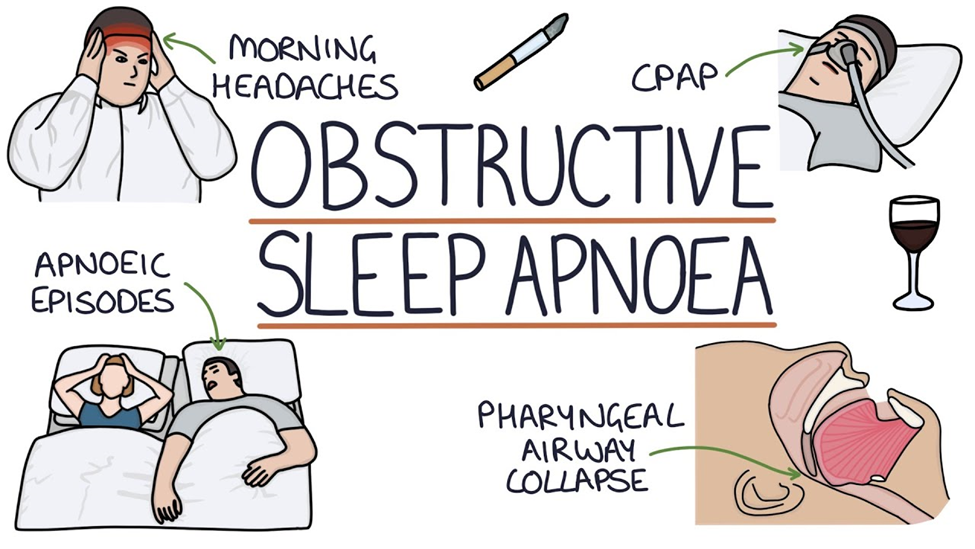A nurse is collecting data on a client who has obstructive sleep apnea. Which of the following findings should the nurse expect?
Constipation
Nausea
Headache
Hypotension
The Correct Answer is C
A. Constipation
Constipation is not typically associated with obstructive sleep apnea. However, sleep disturbances and certain medications used to manage OSA may indirectly contribute to constipation in some cases.
B. Nausea
Nausea is not a common symptom of obstructive sleep apnea. While sleep disturbances may affect gastrointestinal function in some individuals, nausea is not a typical manifestation of OSA.
C. Headache
One of the common findings associated with obstructive sleep apnea (OSA) is headache. This occurs due to the repeated episodes of apnea (cessation of breathing) during sleep, which leads to intermittent hypoxia (low oxygen levels) and subsequent cerebral vasodilation. The vasodilation can trigger headaches, often described as morning headaches, upon waking up. These headaches are typically frontal and may be accompanied by other symptoms such as fatigue and irritability.
D. Hypotension
Hypotension (low blood pressure) is not a typical finding in obstructive sleep apnea. In fact, individuals with OSA are more likely to have hypertension (high blood pressure) due to the effects of repeated apnea episodes on the cardiovascular system, such as increased sympathetic activity and arterial stiffness.

Nursing Test Bank
Naxlex Comprehensive Predictor Exams
Related Questions
Correct Answer is D
Explanation
A. Auscultate breath sounds at least every 2 hours.
Regularly auscultating breath sounds is important for assessing respiratory status and detecting any signs of respiratory complications such as pneumonia or atelectasis. However, it is not the priority action in this scenario compared to applying antiembolic stockings, which directly addresses the increased risk of DVT and PE associated with immobility.
B. Perform range-of-motion exercises at least two to three times daily.
Range-of-motion exercises help prevent contractures and maintain joint mobility in immobile clients. While they are important for preventing musculoskeletal complications, they are not the priority action compared to applying antiembolic stockings, which directly addresses the increased risk of DVT and PE associated with immobility.
C. Make sure the client has an intake of 2,000 to 3,000 mL of fluid per day.
Maintaining adequate hydration is important for overall health and prevention of complications such as urinary tract infections and constipation. However, it is not the priority action in this scenario compared to applying antiembolic stockings, which directly addresses the increased risk of DVT and PE associated with immobility.
D. Apply antiembolic stockings.
The priority action for the nurse to contribute to the plan of care for an immobile client is to apply antiembolic stockings. Immobility increases the risk of deep vein thrombosis (DVT) and subsequent pulmonary embolism (PE). Antiembolic stockings (also known as compression stockings or TED stockings) help prevent venous stasis and decrease the risk of blood clots forming in the lower extremities. Therefore, applying antiembolic stockings is essential in mitigating the risk of potentially life-threatening complications associated with immobility.
Correct Answer is D
Explanation
A. Position the client on the nonoperative side.
Positioning the client on the nonoperative side after a pneumonectomy may not be the best choice. The positioning of the client post-pneumonectomy should be based on factors such as the individual's comfort, respiratory status, and any specific instructions from the healthcare provider. Placing the client on the nonoperative side may inadvertently put pressure on the surgical site, leading to discomfort or potential complications.
B. Monitor respiratory status every 8 hr.
Monitoring respiratory status every 8 hours is not sufficient for a client post-pneumonectomy. After such a major surgical procedure, respiratory status should be closely monitored and assessed more frequently, especially in the immediate postoperative period. This frequency allows for the early detection of any signs of respiratory distress, such as decreased oxygen saturation, dyspnea, or abnormal breath sounds, as well as complications like pneumothorax or atelectasis.
C. Elevate the head of the bed to a 15° angle.
Elevating the head of the bed to a 15° angle is a general recommendation for clients postoperative to promote respiratory function and reduce the risk of aspiration. However, after a pneumonectomy, the positioning of the client may vary based on their individual condition and surgical approach. It's important to follow the healthcare provider's specific instructions regarding positioning for optimal recovery. The angle of elevation may need to be adjusted based on the client's comfort and respiratory status.
D. Encourage the client to splint the incision when coughing.
After a pneumonectomy, it's crucial to encourage the client to splint the incision when coughing. Splinting the incision with a pillow or hands helps to reduce pain and prevent strain on the surgical site, promoting healing and minimizing the risk of complications such as wound dehiscence (opening of the surgical incision).
Whether you are a student looking to ace your exams or a practicing nurse seeking to enhance your expertise , our nursing education contents will empower you with the confidence and competence to make a difference in the lives of patients and become a respected leader in the healthcare field.
Visit Naxlex, invest in your future and unlock endless possibilities with our unparalleled nursing education contents today
Report Wrong Answer on the Current Question
Do you disagree with the answer? If yes, what is your expected answer? Explain.
Kindly be descriptive with the issue you are facing.
